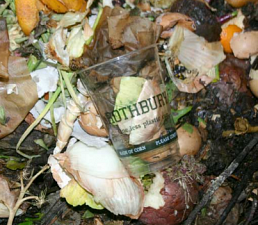Demand spike predicted for biodegradable plastics
By Rikki Stancich
Published on 23 April 2013

A new report from IHS Chemical predicts that demand in Europe, Asia and the US for biodegradable polymers will increase from 269 thousand metric tons (KMT) in 2012 to nearly 525 KMT in 2017. The report authors say demand is being driven by mounting pressure from consumers and legislation such as plastic bag bans and global warming initiatives.
In 2012, Europe was the dominant market for biodegradable polymers consuming 147 KMT or about 55 percent of world consumption; North America accounted for 29 percent and Asia approximately 16 percent. Landfill waste disposal and stringent legislation are key market drivers in Europe and include a packaging waste directive to set recovering and recycling targets, a number of plastic bag bans, and other collection and waste disposal laws to avoid landfill.
Compostable food packaging gains ground
Until now, biodegradable foam packaging has been the biggest biodegradable plastics market driver. Now, according to the report, biodegradable food packaging (including fast-food and beverage containers), dishes and cutlery markets are the largest end-uses that will likely deliver double-digit growth over the next few years. Compostable bags, as well as single-use carrier plastic bags, follow foam packaging in terms of demand volume.
Food packaging, dishes and cutlery can now be composted with the food waste without sorting, delivering huge benefits to reducing food waste and packaging disposal in landfills, explains the report. “Increasing legislation and consumer pressures are also encouraging retailers and manufacturers to seek out these biodegradable products and materials”, noted Michael Malveda, principal analyst of specialty chemicals at IHS Chemical and the report’s lead author.
The report also noted that biodegradable polymers offer expanding uses for biomedical applications and for the oil and gas industry, where they are used during hydraulic fracturing as more environmentally friendly proppants to ‘prop open’ fractures in rock layers so oil and gas can be released.
Market barriers
The main market barriers for biodegradable polymers continue to be price and performance. These barriers will diminish “as processing technologies improve, more applications for their use are developed, and production increases,” said Malveda.
Regulations such as plastic bag bans are being enacted in many countries, and this stimulates new research investments for alternative materials, he added.
Asia’s demand for biodegradable polymers has remained suppressed, likely due to uncompetitive prices. However, the report notes that demand in China is expected to grow rapidly due to new capacity and government legislation supporting the environment. Future growth will also depend on price reductions, Malveda said.
In 2012, the two most important commercial, biodegradable polymers were polylactic acid (PLA) and starch-based polymers, accounting for about 47 percent and 41 percent, respectively, of total biodegradable polymers consumption. Starch sources vary worldwide, but include corn, potatoes, cassava and sugar beets.
In Europe, starch-based biodegradable polymers accounted for 62 percent of the market, followed by PLA, with 24 percent and other biodegradable polymer types with 14 percent.
